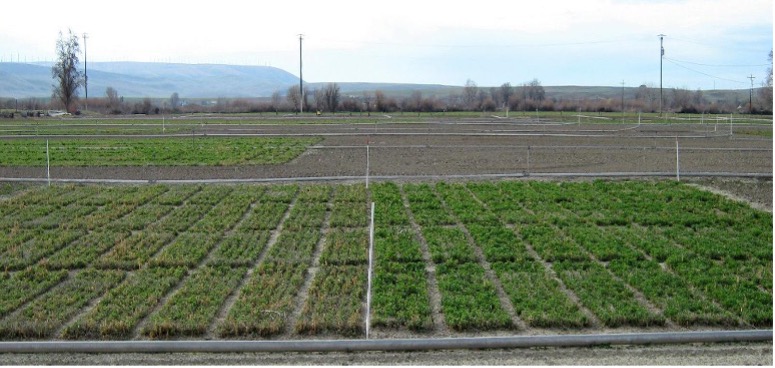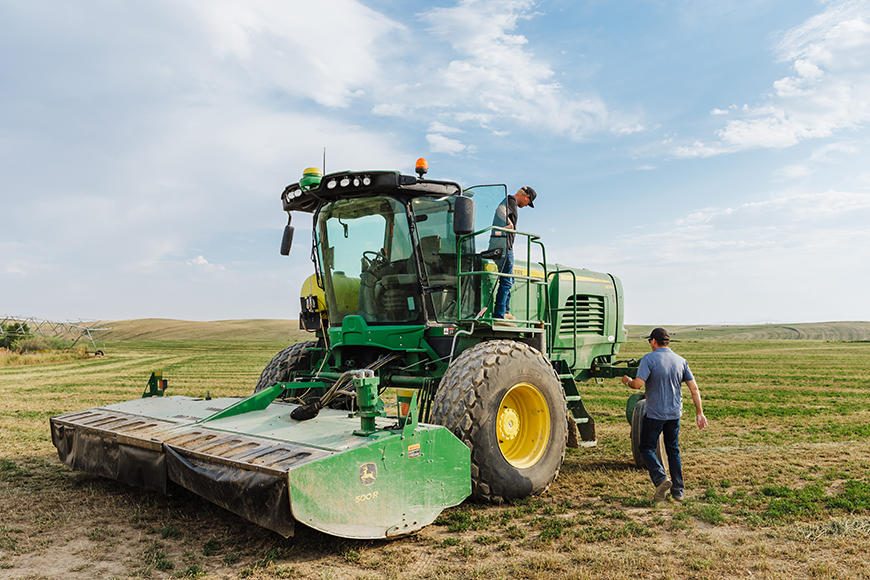Fall is a critical time when managing your alfalfa- improper timing of your last cutting can lead to increased risk for winterkill, as well as decreased vigor in the spring. General recommendations are to allow approximately 45 days between your last harvest and the first killing frost. This ensures alfalfa has the appropriate amount of time not only to regrow, but more importantly to store adequate energy reserves for regrowth in the spring. An alternative strategy is to time your cutting to be immediately prior to a killing frost, where the plant won’t try to regrow and utilize stored carbohydrate reserves.
HarvXtra alfalfa can help to improve overall cutting management throughout the entire season, which can lead to improvements in fall management and ability to store energy reserves. Due to its ability to maintain quality later into maturity, harvest can be delayed which leads to increases in yield and energy reserves, without sacrificing quality. Instead of worrying about harvesting every 25-28 days, harvest can be extended to 32 days or more (depending on your production goals), which can even lead to the ability to eliminate an entire cutting in many situations.
In situations where a cutting can be eliminated, root reserves can be maximized, improving overall persistence and regrowth ability in the spring. This is depicted in Figure 1, where alfalfa plots that were cut one less time the prior year had marked improvement in winter survivability compared to alfalfa plots that were harvested on a more “conventional schedule”.

Figure 1. Alfalfa plots from the Forage Genetics International research station at Boone, IA. All plots were established at the same time, with the same varieties present on both sides of the plots, and all were managed the same for fertility and pest pressure, the only difference was the plots on the left were harvested on a 35-day schedule for a total of 4 times the year prior, while the plots on the right were harvested every 28 days for a total of 5 times the year prior. Notice the plots that experienced winterkill in the circled area.
The other benefit we see is that with decreased harvest stress on the plants, and increased ability to maximize energy reserves, production can be increased. In Figure 2 below, plots were replicated, and all plants were managed similarly on the left and right side of the screen, in exception to number of harvests. Importantly, when yields were evaluated the following spring, the plots that were harvested only five times the year prior had a first cutting production of 4.55 tons/ acre, whereas the plots that were harvested six times the year prior had a total first cutting yield of 3.6 tons/ acre.
 Figure 2. Alfalfa plots from the Forage Genetics International research station at Touchet, WA. All plots were established at the same time, with the same varieties present on both sides of the plots, and all were managed the same for fertility and pest pressure, the only difference was the plots on the left were harvested six times the year prior, while the plots on the right were harvested 5 times the year prior.
Figure 2. Alfalfa plots from the Forage Genetics International research station at Touchet, WA. All plots were established at the same time, with the same varieties present on both sides of the plots, and all were managed the same for fertility and pest pressure, the only difference was the plots on the left were harvested six times the year prior, while the plots on the right were harvested 5 times the year prior.
We see this same trend carry throughout the season as well as from year to year. Figure 3 shows multi-year data evaluating impacts of extended harvest of HarvXtra alfalfa on a 35 day schedule compared to a conventional schedule of Roundup Ready alfalfa cut on a 28 day schedule. Overall, a 30% improvement in yield is observed across all years, with yield improvements increasing from year 1 to year 3. Additionally, there was little to no quality loss associated with the extended harvest and improved yield.

Figure 3. Data evaluating the impacts of harvesting HarvXtra alfalfa on a 35 day schedule compared to Roundup Ready alfalfa on a 28 day schedule.
What does this have to do with fall harvest schedule then? With the flexibility that HarvXtra alfalfa offers, you can plan out your harvests, and potentially fewer harvests throughout the season, allowing more time in that critical fall period for regrowth. As a result, you will have healthier, more vigorous plants that are higher yielding, as well as decreased input costs by not having to cut as many times each year.
We do recommend to not delay your first cutting of the year and maintain that on the same schedule that you would for any conventional alfalfa. The first cutting is the highest yielding of the year, and also the most likely to have issues such as lodging due to that higher mass as well as weather events. Scheduling extended harvests after the first cutting through the rest of the season may have significant payoffs for you, both financially as well as a little more room for fun in your summer calendar.
Download PDF article here.
HarvXtra alfalfa can help to improve overall cutting management throughout the entire season, which can lead to improvements in fall management and ability to store energy reserves. Due to its ability to maintain quality later into maturity, harvest can be delayed which leads to increases in yield and energy reserves, without sacrificing quality. Instead of worrying about harvesting every 25-28 days, harvest can be extended to 32 days or more (depending on your production goals), which can even lead to the ability to eliminate an entire cutting in many situations.
In situations where a cutting can be eliminated, root reserves can be maximized, improving overall persistence and regrowth ability in the spring. This is depicted in Figure 1, where alfalfa plots that were cut one less time the prior year had marked improvement in winter survivability compared to alfalfa plots that were harvested on a more “conventional schedule”.

Figure 1. Alfalfa plots from the Forage Genetics International research station at Boone, IA. All plots were established at the same time, with the same varieties present on both sides of the plots, and all were managed the same for fertility and pest pressure, the only difference was the plots on the left were harvested on a 35-day schedule for a total of 4 times the year prior, while the plots on the right were harvested every 28 days for a total of 5 times the year prior. Notice the plots that experienced winterkill in the circled area.
The other benefit we see is that with decreased harvest stress on the plants, and increased ability to maximize energy reserves, production can be increased. In Figure 2 below, plots were replicated, and all plants were managed similarly on the left and right side of the screen, in exception to number of harvests. Importantly, when yields were evaluated the following spring, the plots that were harvested only five times the year prior had a first cutting production of 4.55 tons/ acre, whereas the plots that were harvested six times the year prior had a total first cutting yield of 3.6 tons/ acre.
 Figure 2. Alfalfa plots from the Forage Genetics International research station at Touchet, WA. All plots were established at the same time, with the same varieties present on both sides of the plots, and all were managed the same for fertility and pest pressure, the only difference was the plots on the left were harvested six times the year prior, while the plots on the right were harvested 5 times the year prior.
Figure 2. Alfalfa plots from the Forage Genetics International research station at Touchet, WA. All plots were established at the same time, with the same varieties present on both sides of the plots, and all were managed the same for fertility and pest pressure, the only difference was the plots on the left were harvested six times the year prior, while the plots on the right were harvested 5 times the year prior.We see this same trend carry throughout the season as well as from year to year. Figure 3 shows multi-year data evaluating impacts of extended harvest of HarvXtra alfalfa on a 35 day schedule compared to a conventional schedule of Roundup Ready alfalfa cut on a 28 day schedule. Overall, a 30% improvement in yield is observed across all years, with yield improvements increasing from year 1 to year 3. Additionally, there was little to no quality loss associated with the extended harvest and improved yield.

Figure 3. Data evaluating the impacts of harvesting HarvXtra alfalfa on a 35 day schedule compared to Roundup Ready alfalfa on a 28 day schedule.
What does this have to do with fall harvest schedule then? With the flexibility that HarvXtra alfalfa offers, you can plan out your harvests, and potentially fewer harvests throughout the season, allowing more time in that critical fall period for regrowth. As a result, you will have healthier, more vigorous plants that are higher yielding, as well as decreased input costs by not having to cut as many times each year.
We do recommend to not delay your first cutting of the year and maintain that on the same schedule that you would for any conventional alfalfa. The first cutting is the highest yielding of the year, and also the most likely to have issues such as lodging due to that higher mass as well as weather events. Scheduling extended harvests after the first cutting through the rest of the season may have significant payoffs for you, both financially as well as a little more room for fun in your summer calendar.
Download PDF article here.



